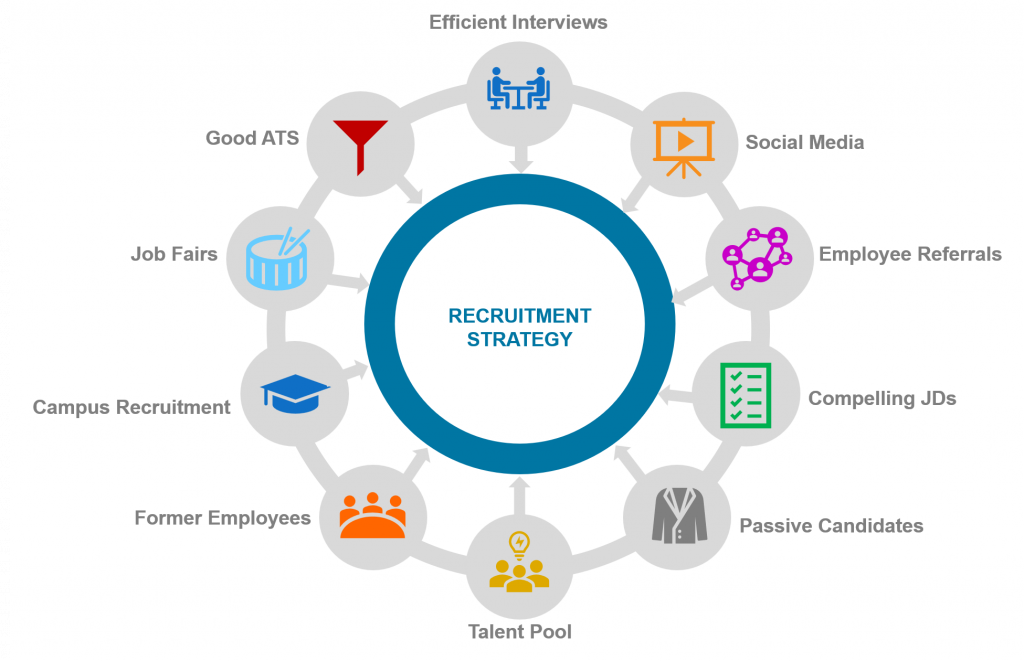Hiring Strategies are crucial to your companies success
Does your hiring strategy come down to posting a job in a few recruitment portals and hoping the right candidate sends in their application? There are many recruitment strategies, but posting and hoping are not the most effective.
Recruitment is a critical part of any business. Every organization has unique resource needs based on their business, clients, domain, technical expertise, and many other factors. Whether you are a business leader or an HR professional, you will have to hire at some point in your career. Having good recruitment strategies will help bring in the right talent into your organization.
Take a look at our top 10 effective hiring strategies:

1. Have an agile interview process:
This process is the most critical part of any recruitment strategy. If you want to close offers, you will need an agile recruitment process. You cannot have four rounds of interviews with a technical test and a behavior assessment span over a month. Review the recruitment process for each role and remove redundancies. Please do not make a candidate repeat themselves with multiple panels of people on different days. Establish clear goals for each round of interviews. Publish it on your career site and request the candidates to familiarize themselves with it. Create interview guides for your hiring managers and train them to stay on point and stick to the goals of each interview round. Complete the interview process in a week and close the offer. Candidates now have many options. They will not wait for you to come around, even if your brand is lucrative.
2. Use social media:
Social media is a fantastic recruitment tool. It allows you to reach out to the people in your network instantly. Even if they are not interested in the job posting, they will pass it on to someone that may be a good fit. The definition of the network has expanded beyond geographical boundaries, friends, family, current and past colleagues. Develop a habit of writing posts at least twice a week. Share your company videos, events you attended, fun days at work, even if it’s just a potluck, and your day-to-day learnings. Being authentic and personal develop faithful followers. Having a good social media presence will come in handy when you need to find that unicorn candidate in record time!
3. Implement an employee referral program:
This is one of the time-tested brilliant recruitment strategies. More than 30% of all hires get filled through employee referrals. Referred candidates are four times likely to get hired because an employee referred them. Trust is implicitly built in both ways. Your colleague and the recruiter now share the responsibility of hiring a dependable and suitable candidate. Another study says that over 45% of employees referred by colleagues stay longer than four years in an organization.
4. Create compelling job descriptions:
A well-written and compelling job description sets the proper foundation for both the candidate and the organization. First, provide a specific and concise job title. The title must represent the job duties accurately. Next, write a strong, attention-grabbing summary of the role. Add the location, work hours, and a note on the work environment. Outline the job’s core responsibilities that provide a day-in-the-life of that role. Share how this position fits into your organization. Add mandatory skill and qualification requirements along with salary range and benefits. Simple and straightforward job descriptions are the most compelling ones to a candidate.
5. Be noticeable to passive candidates:
Passive candidates are currently employed and not actively looking for a job. But they may be open to a good opportunity if it comes their way. Employers like targeting them because they have good employment records and are successful in their current jobs. Be sure to add them to your network, so they get to view your posts and blogs. You need to build a relationship with them over time. They are not looking to switch jobs and cannot be easily convinced with one interaction. Engage with authentic communication. Take an interest in their short- and long-term goals so you can refer the right opportunity to them.
6. Create a talent pool:
Building a talent pool is a long-term strategy in filling positions with higher quality candidates at a lower cost. It’s a database of highly-qualified candidates who are interested in your organization. It’s the most effective method of proactive recruiting. You will need to use sourcing tools, social media, recruiting events, university campuses, and referrals to find these candidates and build followership. Once you find them, you will need to manage them by engaging with them actively.
7. Stay in touch with former employees:
Former employees are also your company’s ambassadors. Be genuine with them and wish them well in their journey. Continue to engage with them by creating an alumni network. Share the direction of your company, innovations, new teams, new lines of businesses, and newer opportunities that are now available. How you treat your alumni speaks volumes about the company’s culture to your current and future employees. And you may find some great fits for some of your open roles.
8. Be visible in local colleges, trade schools, and universities:
Campus recruitment is one of the best ways to build your brand with budding talent in local communities. Based on your business needs, identify local colleges and universities where you can find the right talent pool. Create a campus recruitment strategy for the entire year. Connect with their campus recruitment coordinators and share the plan. If you have specific roles that require trade qualifications, establish the connection between the positions you are hiring for and their courses—partner with the university and conduct workshops on how to prepare for interviews.
Sponsor apprenticeships for aspiring talent. You may not get a direct fit for some of the unique roles, but you can groom and create a pipeline of candidates for the future.
9. Host recruitment events for specific roles:
Recruitment events are essential in building your talent pool and making a great impression as an employer. Create specific goals for each event. For example, if you are looking for Production Engineers, host a focused event. Participate in job fairs and showcase your organization. Create a fair job event at your office premises and invite people to experience a day-in-life at your organization. Shorten the recruitment cycle, and have hiring managers present at such events so hiring decisions can be made in a couple of days as opposed to a couple of weeks.
10. Invest in a suitable Applicant Tracking System (ATS):
If your ATS gives an option to upload the candidate’s resume, it cannot also ask them to fill out ten different forms to complete their profile. Just like how you evaluate the candidates, they are evaluating the organization. This experience is their first impression of the company. They will get disinterested if the application process is elaborate, redundant, or time-consuming and may assume the same about all other functions in your organization. You will lose a candidate that likely would have been a good fit for the role. Have your business leaders review the recruitment strategy, test the ATS from time to time and share their feedback.
In conclusion, recruitment Is not just a critical business component but also a great way to build your company brand. Therefore, it is essential to have a good long-term and short-term strategy to attract the right talent successfully.
Related Resource: Best Hiring Practices – Top Questions Answered
Related Blog Post: Top 5 Things an Applicant Tracking System does wrong


 Dr. Jaffee (M.A., Ph.D.) is a recognized expert in the field of assessments, and has created effective HR Solutions used by millions of people.
Dr. Jaffee (M.A., Ph.D.) is a recognized expert in the field of assessments, and has created effective HR Solutions used by millions of people.